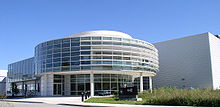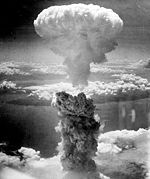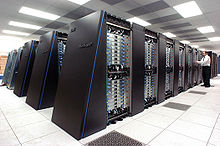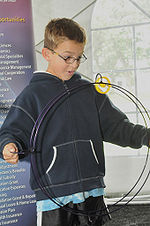- Argonne National Laboratory
-
Argonne National Laboratory Established 1946 Research Type Research Field of Research Physical science
Life science
Environmental science
Energy science
Photon scienceDirector Eric Isaacs Staff 3200 Address 9700 S. Cass Avenue Location Downers Grove Township, DuPage County, Illinois, USA Telephone (630) 252-2000 Campus 1,700 acres (6.9 km2) Affiliations United States Department of Energy
University of Chicago
Jacobs Engineering
University of Illinois at ChicagoNobel Laureates Enrico Fermi
Maria Goeppert Mayer
Alexei Alexeyevich AbrikosovWebsite anl.gov Argonne National Laboratory is the first science and engineering research national laboratory in the United States, receiving this designation on July 1, 1946.[1] It is the largest national laboratory by size and scope in the Midwest. A multipurpose laboratory led since 2009 by director Eric Isaacs,[2] Argonne maintains a broad portfolio in basic science research, energy storage and renewable energy, environmental sustainability, and national security. It is managed for the United States Department of Energy by UChicago Argonne, LLC, which is composed of the University of Chicago and Jacobs Engineering Group Inc.[3] Argonne is a part of the expanding Illinois Technology and Research Corridor.
The laboratory is located on 1,700 acres (6.9 km2) in DuPage County, 25 miles (40 km) southwest of Chicago, Illinois, on Interstate 55, completely encircled by Waterfall Glen Forest Preserve. When it was first established it was known as the University of Chicago's Metallurgical Laboratory (Met Lab), and it was previously located within Red Gate Woods. Early in its history, the laboratory was part of the Manhattan Project, which built the first atomic bomb.
Argonne National Laboratory had a smaller facility called Argonne National Laboratory-West (or simply Argonne-West) in Idaho next to the Idaho National Engineering and Environmental Laboratory. In 2005, the two Idaho-based laboratories merged together to become the Idaho National Laboratory.[4]
Contents
Overview
Argonne has five main areas of focus.[5][6] These goals, as stated by the DOE in 2008,[7] consist of:
- Conducting basic scientific research;
- Operating national scientific facilities;
- Enhancing the nation's energy resources;
- Developing better ways to manage environmental problems;
- Protecting national security.
History
Argonne traces its birth from Enrico Fermi's secret charge — the Manhattan Project — to create the world's first self-sustaining nuclear reaction. Code-named the "Metallurgical Lab", the team constructed Chicago Pile-1, which achieved criticality on December 2, 1942, underneath the University of Chicago's Stagg football field stands. Because the experiments were deemed too dangerous to conduct in a major city, the operations were moved to a spot in nearby Palos Hills and renamed "Argonne" after the surrounding forest.
On July 1, 1946, the laboratory was formally chartered as Argonne National Laboratory to conduct "cooperative research in nucleonics." At the request of the U.S. Atomic Energy Commission, it began developing nuclear reactors for the nation's peaceful nuclear energy program. In the late 1940s and early 1950s, the laboratory moved to a larger location in Lemont, Illinois, and established a remote location in Idaho, called "Argonne-West," to conduct further nuclear research.
In quick succession, the laboratory designed and built Chicago Pile 3, the world's first heavy-water moderated reactor, and the Experimental Breeder Reactor I, built in Idaho, which lit a string of four light bulbs to produce the world's first nuclear-generated electricity in 1951. A complete list of the reactors designed and, in most cases, built and operated by Argonne can be viewed in the, "Reactors Designed by Argonne" page. The knowledge gained from the Argonne experiments conducted with these reactors 1) formed the foundation for the designs of most of the commercial reactors currently used throughout the world for electric power generation and 2) inform the current evolving designs of liquid-metal reactors for future commercial power stations.
Conducting classified research, the laboratory was heavily secured; all employees and visitors needed badges to pass a checkpoint, many of the buildings were classified, and the laboratory itself was fenced and guarded. Such alluring secrecy drew visitors both authorized — including King Leopold III of Belgium and Queen Frederica of Greece[8] — and unauthorized. Shortly past 1 a.m. on February 6, 1951, Argonne guards discovered reporter Paul Harvey near the 10-foot (3.0 m) perimeter fence, his coat tangled in the barbed wire. Searching his car, guards found a previously prepared four-page broadcast detailing the saga of his unauthorized entrance into a classified "hot zone". He was brought before a federal grand jury on charges of conspiracy to obtain information on national security and transmit it to the public, but was not indicted.[9]
Not all nuclear technology went into developing reactors, however. While designing a scanner for reactor fuel elements in 1957, Argonne physicist William Nelson Beck put his own arm inside the scanner and obtained one of the first ultrasound images of the human body.[10] Remote manipulators designed to handle radioactive materials laid the groundwork for more complex machines used to clean up contaminated areas, sealed laboratories or caves.[11] In 1964, the "Janus" reactor opened to study the effects of neutron radiation on biological life, providing research for guidelines on safe exposure levels for workers at power plants, laboratories and hospitals.[12] Scientists at Argonne pioneered a technique to analyze the moon's surface using alpha radiation, which launched aboard the Surveyor 5[13] in 1967 and later analyzed lunar samples from the Apollo 11 mission.
In addition to nuclear work, the laboratory maintained a strong presence in the basic research of physics and chemistry. In 1955, Argonne chemists co-discovered the elements einsteinium and fermium, elements 99 and 100 in the periodic table.[14] In 1962, laboratory chemists produced the first compound of the inert noble gas xenon, opening up a new field of chemical bonding research.[15] In 1963, they discovered the hydrated electron.[16]
 Albert Crewe (right), Argonne's third director, stands next to the Zero Gradient Synchrotron's Cockcroft-Walton generator.
Albert Crewe (right), Argonne's third director, stands next to the Zero Gradient Synchrotron's Cockcroft-Walton generator.
High-energy physics made a leap forward when Argonne was chosen as the site of the 12.5 GeV Zero Gradient Synchrotron, a proton accelerator that opened in 1963. A bubble chamber allowed scientists to track the motions of subatomic particles as they zipped through the chamber; in 1970, they observed the neutrino in a hydrogen bubble chamber for the first time.[17]
Meanwhile, the laboratory was also helping to design the reactor for the world's first nuclear-powered submarine, the U.S.S. Nautilus, which steamed for more than 513,550 nautical miles (951,090 km). The next nuclear reactor model was Experimental Boiling Water Reactor, the forerunner of many modern nuclear plants, and Experimental Breeder Reactor II (EBR-II), which was sodium-cooled, and included a fuel recycling facility. EBR-II was later modified to test other reactor designs, including a fast-neutron reactor and, in 1982, the Integral Fast Reactor concept — a revolutionary design that reprocessed its own fuel, reduced its atomic waste and withstood safety tests of the same failures that triggered the Chernobyl and Three Mile Island disasters.[18] In 1994, however, the U.S. Congress terminated funding for the bulk of Argonne's nuclear programs.
Argonne moved to specialize in other areas, while capitalizing on its experience in physics, chemical sciences and metallurgy. In 1987, the laboratory was the first to successfully demonstrate a pioneering technique called plasma wakefield acceleration, which accelerates particles in much shorter distances than conventional accelerators.[19] It also cultivated a strong battery research program.
Following a major push by then-director Alan Schriesheim, the laboratory was chosen as the site of the Advanced Photon Source, a major X-ray facility which was completed in 1995 and produced the brightest X-rays in the world at the time of its construction.
Directors
Over the course of its history, 11 eminent scientists have served as Argonne Director:
- 1946–1956 Walter Zinn
- 1957–1961 Norman Hilberry
- 1961–1967 Albert V. Crewe
- 1967–1973 Robert B. Duffield
- 1973–1979 Robert G. Sachs
- 1979–1984 Walter E. Massey
- 1984–1996 Alan Schriesheim
- 1996–1998 Dean E. Eastman
- 2000–2005 Hermann A. Grunder
- 2005–2008 Robert Rosner
- 2009–present Eric Isaacs
Initiatives
- Hard X-ray Sciences — Argonne is home to one of the world’s largest high-energy light sources: the Advanced Photon Source (APS). Each year, scientists make thousands of discoveries while using the APS to characterize both organic and inorganic materials and even processes, such as how vehicle fuel injectors spray gasoline in engines.[20]
- Leadership Computing — Argonne maintains one of the fastest computers for open science, the IBM Blue Gene/P supercomputer, and has developed system software for these massive machines. Argonne works to drive the evolution of leadership computing from petascale to exascale, develop new codes and computing environments, and expand computational efforts to help solve scientific challenges. For example, in October 2009, the laboratory announced that it would be embarking on a joint project to explore cloud computing for scientific purposes.[21]
- Materials for Energy — Argonne scientists work to predict, understand, and control where and how to place individual atoms and molecules to achieve desired material properties. Among other innovations, Argonne scientists helped develop an ice slurry to cool the organs of heart attack victims,[22] described what makes diamonds slippery at the nanoscale level,[23] and discovered a superinsulating material that resists the flow of electric current more completely than any other previous material.[24]
- Electrical Energy Storage — Argonne develops batteries for electric transportation technology grid storage for intermittent energy sources like wind or solar, and the manufacturing processes for these materials-intensive devices.[25] The laboratory has been working on advanced battery research and development for over 40 years.[26] In the past 10 years, the laboratory has focused on lithium-ion batteries, and in September 2009, it announced an initiative to explore and improve their capabilities.[27] Argonne also maintains an independent battery-testing facility, which tests sample batteries from both government and private industry to see how well they perform over time and under heat and cold stresses.[28]
- Alternative Energy and Efficiency — Argonne develops both chemical and biological fuels tailored for current engines as well as improved combustion schemes for future engine technologies. The laboratory has also recommended best practices for conserving fuel; for example, a study that recommended installing auxiliary cab heaters for trucks in lieu of idling the engine.[29] Meanwhile, the solar energy research program focuses on solar-fuel and solar-electric devices and systems that are scalable and economically competitive with fossil energy sources.[30] Argonne scientists also explore best practices for a smart grid, both by modeling power flow between utilities and homes and by researching the technology for interfaces.[31]
- Nuclear Energy — Argonne generates advanced reactor and fuel cycle technologies that enable the safe, sustainable generation of nuclear power. Argonne scientists develop and validate computational models and reactor simulations of future generation nuclear reactors.[32] Another project studies how to reprocess spent nuclear fuel, so that waste is reduced up to 90%.[33]
- Biological and Environmental Systems — Understanding the local effect of climate change requires integration of the interactions between the environment and human activities. Argonne scientists study these relationships from molecule to organism to ecosystem. Programs include bioremediation using trees to pull pollutants out of groundwater;[34] biochips to detect cancers earlier;[35] a project to target cancerous cells using nanoparticles;[36] soil metagenomics; and a major climate change research project, ARM.[37]
- National Security — Argonne develops security technologies that will prevent and mitigate events with potential for mass disruption or destruction. These include sensors that can detect chemical, biological, nuclear and explosive materials;[38] portable Terahertz radiation ("T-ray") machines that detect dangerous materials more easily than X-rays at airports;[39] and tracking and modeling the possible paths of chemicals released into a subway.[40]
User facilities
 Argonne's Center for Nanoscale Materials.
Argonne's Center for Nanoscale Materials.
Argonne builds and maintains scientific facilities that would be too expensive for a single company or university to construct and operate. These facilities are used by scientists from Argonne, private industry, academia, other national laboratories and international scientific organizations.
- Advanced Photon Source (APS) – a national synchrotron X-ray research facility which produces the brightest x-ray beams in the Western Hemisphere.[41]
- Center for Nanoscale Materials (CNM) – a user facility located on the APS which provides infrastructure and instruments to study nanotechnology and nanomaterials. The CNM is one of five U.S. Department of Energy Office of Science Nanoscale Science Research Centers.[42]
- Argonne Tandem Linac Accelerator System (ATLAS) – ATLAS is the world's first superconducting particle accelerator for heavy ions at energies in the vicinity of the Coulomb barrier. This is the energy domain suited to study the properties of the nucleus, the core of matter and the fuel of stars.[43]
- Electron Microscopy Center (EMC) – one of three DOE-supported scientific user facilities for electron beam microcharacterization. The EMC conducts in situ studies of transformations and defect processes, ion beam modification and irradiation effects, superconductors, ferroelectrics and interfaces. Its intermediate voltage electron microscope, which is coupled with an accelerator, represents the only such system in the United States.[44]
 Argonne's Advanced Photon Source facility
Argonne's Advanced Photon Source facility
- Argonne Leadership Computing Facility – Provides leadership-class computing resources, including computer time, resources and data storage, to the scientific community. Argonne is home to Intrepid, an IBM Blue Gene/P supercomputer, recently ranked the second most energy-efficient supercomputer of its class by Green500[45] and ranked the eighth-fastest supercomputer worldwide.[46]
- Structural Biology Center (SBC) – The SBC is a user facility located off the Advanced Photon Source X-ray facility, which specializes in macromolecular crystallography. Users have access to an insertion-device, a bending-magnet, and a biochemistry laboratory. SBC beamlines are often used to map out the crystal structures of proteins; in the past, users have imaged proteins from anthrax, meningitis-causing bacteria, salmonella, and other pathogenic bacteria.[47]
- Transportation Research & Analysis Computing Center (TRACC) – a facility which uses high-performance computing to analyze and create data and visual models for a variety of transportation issues, including crashworthiness, aerodynamics, combustion, thermal management, weather modeling and traffic simulation.[48]
- Atmospheric Radiation Measurement Climate Research Facility (ARM) – Argonne is one of nine national laboratories which contribute to the ARM program, designed to research global climate change. Argonne oversees ARM operations and manages a meteorological data-gathering site in Oklahoma and a mobile data-gathering facility.[49]
- The Network Enabled Optimization System (NEOS) Server is the first network-enabled problem-solving environment for a wide class of applications in business, science, and engineering. Included are state-of-the-art solvers in integer programming, nonlinear optimization, linear programming, stochastic programming, and complemetarity problems. Most NEOS solvers accept input in the AMPL modeling language.
Educational and community outreach
Argonne welcomes all members of the public age 16 or older to take guided tours of the scientific and engineering facilities and grounds. Tours last about two and a half hours. For children under 16, Argonne offers a range of hands-on learning activities suitable for K-12 field trips and scout outings. The laboratory also hosts educational science and engineering outreach for schools in the surrounding area.
Argonne scientists and engineers help advance science, engineering, and mathematics education in the United States by taking part in the training of nearly 1,000 college graduate students and post-doctoral researchers every year as part of their research and development activities.
Argonne in modern media
Significant portions of the 1996 chase movie Chain Reaction were filmed in the Zero-Gradient Synchrotron ring room and the former Continuous Wave Deuterium Demonstrator laboratory.[1]
Notable staff
- Alexei Alexeyevich Abrikosov
- Rodney Cotterill
- Walter E. Massey
- Maria Goeppert Mayer
- Gilbert Jerome Perlow
- Nestor J. Zaluzec
See also
- Canadian Penning Trap Spectrometer
- Gammasphere
- Track Imaging Cherenkov Experiment
External links
- Argonne National Laboratory Official Argonne website
- Argonne News News releases, media center
- Argonne Experts Guide Experts for the media
- Argonne's major initiatives Argonne's major initiatives
- Photo repository Photography for public use
Coordinates: 41°42′33″N 87°58′55″W / 41.709166°N 87.981992°W
Notes
- ^ Holl, Hewlett, and Harris, page xx (Introduction).
- ^ David Kramer (2009). "New Argonne head is chosen". Physics Today 62 (5): 32. Bibcode 2009PhT....62e..32K. doi:10.1063/1.3141937.
- ^ http://www.uchicagoargonnellc.org/
- ^ .:Post Register — Idaho Falls, ID:. INL History
- ^ Welcome to Argonne
- ^ About Argonne
- ^ "Argonne National Laboratory". U.S. Department of Energy. http://humansubjects.energy.gov/labs/argonne.htm. Retrieved 2009-12-14.
- ^ "Argonne Highlights: 1950-1959". Argonne National Laboratory. http://www.anl.gov/Science_and_Technology/History/fifties.html.
- ^ Stephens, Joel (2010-01-23). "New documents show longtime friendship between J. Edgar Hoover and Paul Harvey". Washington Post. http://www.washingtonpost.com/wp-dyn/content/article/2010/01/22/AR2010012202602.html.
- ^ "William Nelson "Nels" Beck: Joliet Physicist's Work Changed Medical World". CityofJoliet.com. http://www.cityofjoliet.com/halloffame/scientists/wnbeck.htm.
- ^ Holl, Hewlett, and Harris, page 126
- ^ "Research helps safeguard nuclear workers worldwide". Argonne National Laboratory. http://www.anl.gov/Media_Center/News/History/news960803.html.
- ^ Jacobsen, Sally (December 1971). "Getting Aboard Viking: No Room on the Mars Lander.". http://books.google.com/books?id=JgsAAAAAMBAJ&pg=PA49&lpg=PA49&dq=argonne+surveyor+5#v=onepage&q=argonne%20surveyor%205&f=false.
- ^ Holl, Hewlett, and Harris, page 179.
- ^ Holl, Hewlett, and Harris, page 226.
- ^ "Argonne History: Innovation and Serendipity". Argonne National Laboratory. http://www.anl.gov/Science_and_Technology/History/Anniversary_Frontiers/chemhist.html.
- ^ Patel, page 23
- ^ "Frontline: Nuclear Reaction: Interview with Dr. Charles Till". PBS. http://www.pbs.org/wgbh/pages/frontline/shows/reaction/interviews/till.html.
- ^ "Argonne History: Understanding the Physical Universe". Argonne National Laboratory. http://www.anl.gov/Science_and_Technology/History/Anniversary_Frontiers/physhist.html#neutrino.
- ^ "New X-ray technique may lead to better, cleaner fuel injectors for automobiles". Argonne National Laboratory. 2008-02-19. http://www.anl.gov/Media_Center/News/2008/news080219.html.
- ^ "DOE to explore scientific cloud computing at Argonne, Lawrence Berkeley national laboratories". Argonne National Laboratory. 2009-10-14. http://www.anl.gov/Media_Center/News/2009/news091014a.html.
- ^ Gupta, Manya (2009-11-10). "Medical care on ice". Medill Reports. http://news.medill.northwestern.edu/chicago/news.aspx?id=145701.
- ^ "Engineers reveal what makes diamonds slippery at the nanoscale". Science Centric. 2008-06-26. http://www.sciencecentric.com/news/article.php?q=08062610.
- ^ "Newly discovered 'superinsulators' promise to transform materials research, electronics design". Argonne National Laboratory. 2008-04-04. http://www.anl.gov/Media_Center/News/2008/MSD080404.html.
- ^ Mandel, Jenny (2009-08-24). "Chemistry Change in Batteries Could Make for Safer Electric Cars". New York Times. http://www.nytimes.com/gwire/2009/08/24/24greenwire-chemistry-change-in-batteries-could-make-for-s-34626.html.
- ^ "Building better batteries". U.S. Department of Energy. Retrieved 2009-12-13. http://www.energy.gov/discovery/building_better_batteries.html.
- ^ "Argonne opens new chapter in battery research: Li-Air". Argonne National Laboratory. 2009-09-15. http://www.anl.gov/Media_Center/News/2009/batteries090915.html.
- ^ "Battery Test Facility". Argonne National Laboratory, Transportation Center. Retrieved 2009-12-13. http://www.transportation.anl.gov/facilities/battery_lab.html.
- ^ Leavitt, Wendy (1998-08-01). "Not Just Idle Talk". Fleet Owner. http://fleetowner.com/mag/fleet_not_idle_talk_2/.
- ^ "Argonne, Northwestern seek ANSER to solar energy challenges". Argonne National Laboratory. 2007-05-08. http://www.anl.gov/Media_Center/News/2007/news070509.html.
- ^ "Grid Research: Making the Grid Smarter". Argonne National Laboratory Transportation Center. 2009-08-01. http://www.transportation.anl.gov/smart_grid/index.html.
- ^ "Putting the new in nuclear". Argonne National Laboratory magazine. Fall 2009. http://www.anl.gov/Media_Center/ArgonneNow/Fall_2009/nuclear.html.
- ^ . Science Channel. http://www.youtube.com/watch?v=FMhruDLNwBI.
- ^ "Argonne Cleans Up Brownfield Sites [video"]. CleanSkies Network. 2009-11-10. http://www.cleanskies.com/videos/argonne-cleans-brownfield-sites.
- ^ "Biochips can detect cancers before symptoms develop". Argonne National Laboratory. 2008-05-09. http://www.anl.gov/Media_Center/News/2008/ES080509.html.
- ^ Wang, Ann (2009-12-03). "Magnetic microdiscs target and initiate cell death in tumors". Johns Hopkins Newsletter. http://media.www.jhunewsletter.com/media/storage/paper932/news/2009/12/03/ScienceTech/Magnetic.Microdiscs.Target.And.Initiate.Cell.Death.In.Tumors-3845476.shtml.
- ^ "ARRA funding to help scientists better understand climate change". Argonne National Laboratory. 2009-12-08. http://www.anl.gov/Media_Center/News/2009/news091208.html.
- ^ "New sensor technology detects chemical, biological, nuclear and explosive materials". Argonne National Laboratory. 2006-03-21. http://www.anl.gov/Media_Center/News/2006/news060321.html.
- ^ "New T-ray source could improve airport security, cancer detection". Argonne National Laboratory. 2007-11-23. http://www.anl.gov/Media_Center/News/2007/MSD071123.html.
- ^ Szaniszlo, Marie (2009-12-06). "MBTA preps for biological terror attack". Boston Herald. http://www.bostonherald.com/news/regional/view/20091206mbta_preps_for_biological_terror_attack/.
- ^ Argonne About the APS
- ^ Department of Energy Nanoscale Science Research Centers
- ^ About ATLAS
- ^ About the EMC
- ^ Schwartz, Ariel (2008-12-29). "Argonne National Laboratory Debuts Energy Efficient 557 TFlop Supercomputer". CleanTechnica.com. http://cleantechnica.com/2008/12/29/argonne-national-laboratory-debuts-energy-efficient-557-tflop-supercomputer/.
- ^ India Times
- ^ Midwest Center for Structural Genomics Deposit Their 1,000th Protein Structure into Protein Data Bank
- ^ About TRACC
- ^ ARM Laboratory Partners
References
- Argonne National Laboratory, 1946-96. Jack M. Holl, Richard G. Hewlett, Ruth R. Harris. University of Illinois Press, 1997. ISBN 9780252023415.
- Nuclear physics: an introduction. S.B. Patel. New Age International Ltd., 1991. ISBN 8122401252.
Manhattan Project Sites 
Administrators Vannevar Bush · James Conant · Thomas Farrell · Leslie Groves · Franklin Matthias · Kenneth Nichols · Robert Oppenheimer · William ParsonsScientists Hans Bethe · Niels Bohr · James Chadwick · Arthur Compton · Enrico Fermi · Richard Feynman · Klaus Fuchs · George Kistiakowsky · Ernest Lawrence · William Penney · Emilio G. Segrè · Glenn T. Seaborg · Leó Szilárd · Edward Teller · Richard C. Tolman · Stanislaw Ulam · Harold Urey · Leona Woods · Chien-Shiung WuRelated articles Timeline · History of nuclear weapons · Nuclear weapons and the United States · S-1 Uranium Committee · Chicago Pile-1 · X-10 Graphite Reactor · Y-12 National Security Complex · Operation Alsos · Smyth Report · Project Alberta · 509th Operations Group · Fat Man · Little Boy · Enola Gay · Bockscar · The Great Artiste · Atomic bombings of Hiroshima and Nagasaki (debate) · Atomic Spies · Atomic Energy Act of 1946 · Operation Crossroads · Tube AlloysMunicipalities and communities of DuPage County, Illinois Cities Aurora‡ | Batavia‡ | Chicago‡ | Darien | Elmhurst‡ | Naperville‡ | Oakbrook Terrace | St. Charles‡ | Warrenville | West Chicago | Wheaton | Wood Dale
Villages Addison | Bartlett‡ | Bensenville‡ | Bloomingdale | Bolingbrook‡ | Burr Ridge‡ | Carol Stream | Clarendon Hills | Downers Grove | Elk Grove Village‡ | Glendale Heights | Glen Ellyn | Hanover Park‡ | Hinsdale‡ | Itasca | Lemont‡ | Lisle | Lombard | Oak Brook‡ | Roselle‡ | Schaumburg‡ | Villa Park | Wayne‡ | Westmont | Willowbrook | Willow Springs‡ | Winfield | Woodridge‡
Townships Addison | Bloomingdale | Downers Grove | Lisle | Milton | Naperville | Wayne | Winfield | York
Unincorporated
communitiesCloverdale | Eola | Flowerfield | Keeneyville | Lakewood | Medinah | Palisades | York Center
Footnotes ‡This populated place also has portions in an adjacent county or counties
University of Chicago Academics Schools
Other
The College · Divinity School · Booth School of Business · Harris School of Public Policy Studies · Law School · Pritzker School of Medicine · School of Social Service Administration · Graham School of Continuing Liberal and Professional Studies
Argonne National Laboratory · Chicago school of economics · Committee on Social Thought · Fermilab · Oriental Institute · Laboratory Schools · Sonia Shankman Orthogenic School · Milton Friedman Institute · Medical Center · Yerkes ObservatoryResidence halls Campus Chicago Theological Seminary · George Herbert Jones Laboratory · Gerald Ratner Athletics Center · Hutchinson Hall · John Crerar Library · Lorado Taft Midway Studios · Midway Plaisance · Oriental Institute · Quadrangle Club · Regenstein Library · Renaissance Society · Robie House · Rockefeller Chapel · Seminary Co-op · Smart Museum of Art · Stagg FieldHistory Chicago Pile-1 (Nuclear Energy) · Alumni · Faculty · Metallurgical Laboratory · Nobel Laureates · Old University of ChicagoSports and traditions Student organizations The Chicago Maroon · Chicago Weekly · Counterpoint · Off-Off Campus · The Chicago Review · The Midway Review · Doc Films · University of Chicago Band · WHPK-FM · Voices in Your HeadCategories:- Buildings and structures in DuPage County, Illinois
- Nuclear research centers
- Supercomputer sites
- Leadership in Energy and Environmental Design certified buildings
- Argonne National Laboratory
- Lemont, Illinois
- United States Department of Energy National Laboratories
- University of Chicago
- Visitor attractions in DuPage County, Illinois
Wikimedia Foundation. 2010.





